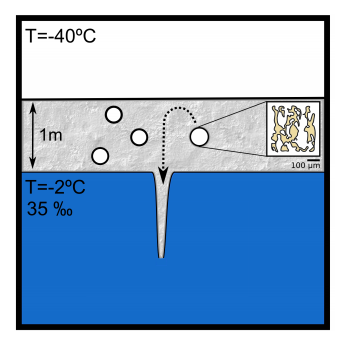Brinicles and the Origin of Life
One of the more curious processes that occur beneath the Antarctic sea ice in winter is the formation of brinicles. These are hollow tubes of ice that project down from the ice pack into the sea below, like icicles.

However, brinicles form in a very different way from icicles but are poorly understood, partly because of the difficulty in observing them. Indeed, they were only filmed forming in situ for the first time for the BBC documentary frozen planet which aired in 2011.
Today, Julyan Cartwright at the University of Granada in Spain and a few pals hope to change that by examining the formation, chemistry and structure of brinicles in more detail. They say the structures are a special form of chemical system known as a chemical garden that depends crucially on the interplay between highly concentrated brine, water close to its freezing point and the formation of ice.
But more interestingly, they say that brinicles may have played an important role in the origin of life on Earth and that similar structures elsewhere in the solar system could be equally important.
Conventional chemical gardens are tubular structures that form when metal salt crystals are immersed in certain solutions.
They occur in a number of natural situations such as in some geological formations and around hydrothermal vents.
Usually, the tubular structures grow upwards. But in brinicles, the tubes grow downwards, so what gives?
The effect occurs in the ice below the sea surface because brine has a lower freezing point then water. When trapped seawater freezes, it excludes salt increasing the salinity the brine nearby and lowering its freezing point even further.
If the ice cracks, the trapped brine can leak into the sea below and flows downwards, because it is denser than water.
What’s more, because it is so cold, the brine turns any seawater it meets into ice. That’s how the tubular structure forms and continues to grow as long as the brine flows.
This process raises interesting questions for physicists. For example, the process by which ice rejects salt to increase the salinity of brine has interesting similarities to the process of osmosis in reverse.
That’s important because reverse osmosis is the key process at work in the desalination plants that turn seawater into drinking water.
It’s just possible that a better understanding of how brinicles perform the same process to produce pure ice could lead to better ways of doing this.
But Cartwright and co’s most interesting observation is that brinicles also create chemical gradients, electric potentials and membranes–all the conditions necessary for the formation of life.
Exactly the same conditions occur at hydrothermal vents which have been the focus of attention for many biologists wanting to better understand how life might have formed.
The point that Cartwright and co-make is that brinicles can be just as interesting. “As brinicles play an important role in the dynamics of brine transport through sea ice, they might also play a role in this scenario of a cold origin of life, just as hydrothermal vents do in the hot environment theories,” they say.
What’s more, brinicles could well be ubiquitous on ocean bearing planets and moons such as Europa, where they might play equally interesting roles.
Clearly, a fascinating area where further work could be highly fruitful.
Ref: arxiv.org/abs/1304.1774: Brinicles as a Case of Inverse Chemical Gardens
Keep Reading
Most Popular
Large language models can do jaw-dropping things. But nobody knows exactly why.
And that's a problem. Figuring it out is one of the biggest scientific puzzles of our time and a crucial step towards controlling more powerful future models.
The problem with plug-in hybrids? Their drivers.
Plug-in hybrids are often sold as a transition to EVs, but new data from Europe shows we’re still underestimating the emissions they produce.
Google DeepMind’s new generative model makes Super Mario–like games from scratch
Genie learns how to control games by watching hours and hours of video. It could help train next-gen robots too.
How scientists traced a mysterious covid case back to six toilets
When wastewater surveillance turns into a hunt for a single infected individual, the ethics get tricky.
Stay connected
Get the latest updates from
MIT Technology Review
Discover special offers, top stories, upcoming events, and more.